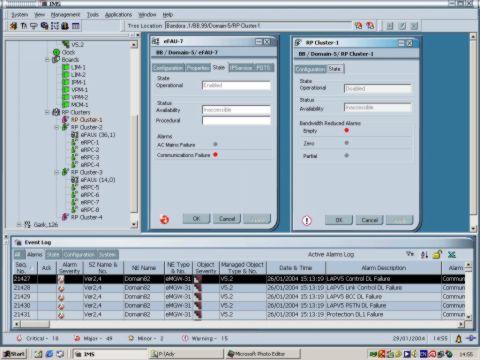eMGW Management
IMS Network Management System
The IMS is the eMGW management solution that uniquely integrates the management of all operation levels, into one management system. The IMS ensures that all systems work systematically, efficiently and securely. Equipped with multi-manager, the IMS enables complete and simple network management.
Carrier Class Management System
The large capacity and scalability of the IMS allows management of vast numbers of Network Elements (NEs), via an easy to operate Graphic User Interface (GUI) designed in accordance with its three-tiered geographical architecture:
Radio Cell / Base Controller Site: Location of radio transceivers co-located on the same base station controller site
Service Zone: The area covered by an independent group of radio cells
Service Area: The wide area served by a particular operator, which includes several service zones
The IMS provides three hierarchical levels of operation:
Local Craft IMS: The Local Craft is a single-user, single NE manager that is used by technicians to configure, manage and maintain individual NEs
Regional IMS: The Regional level includes comprehensive tools for managing eMGW equipment operated in several service zones defined by the system administrator.
Central Management: Central Manager-based on the Operator’s management system and using IMS Regional connections to it. A preliminary definition phase is needed to conduct with the Operator in order to define the interfaces, the functionality required and the complete solution.
The IMS system architecture supports multi-manager access of the same NE from different hierarchical level. Thus all managers are simultaneously updated with NE event, status or configuration changes.
Ease of Operation
The IMS runs on a standard Windows 2000 platform and uses a simple to use GUI interface. The same Man Machine Interface (MMI) in the Local Craft and Regional IMS, is used to manage all network elements and operation levels enabling smooth navigation and easy operation of the IMS.

IMS Main Screen
Compliant with TMN Standards
The IMS supports common network management applications in compliance with TMN standards and requirements including:
Fault Management: Alarm surveillance including alarm and state report, alarm sorting, filtering and reports, alarm log, history log summarized alarms and alarm acknowledgment. Fault Reports as well as Inventory Reports are available and can be supplied as an option.
Configuration Management: Managed object creation, unit and board configuration, telephony and data service provisioning, traffic management tools and over-the-air software download
Performance Management: Provides monitoring of over-the-air circuit and packet traffic load; distribution in time, base station resources and quality of service to maximize traffic capacity and minimize resource requirements. Traffic Management Reports are available and can be supplied as an option. Real Time Air Link Statistics for Air Link technical performance (WER-equivalent to BER; RSS, Most disturbed frequency, etc) is also available
Security Management: Operator and subscriber security facilities
Database Oriented
The IMS utilizes an Oracle database to store information relating to the access network configuration, alarms/events, security, subscribers, messages and Telephony / Data services allocated to the user. Standards and easy to use report generation tools are implemented using the advanced features of the Oracle database.
IMS - Flexible and Scaleable Architecture
The architecture of the IMS is Client Server oriented and includes the following:
The software utilizes industry proven standard tools:
Protocols: TCP/IP, SNMP, tFTP, COM/DCOM
Platform: Standard PC work stations with Windows 2000 operating systems
Database: Oracle

